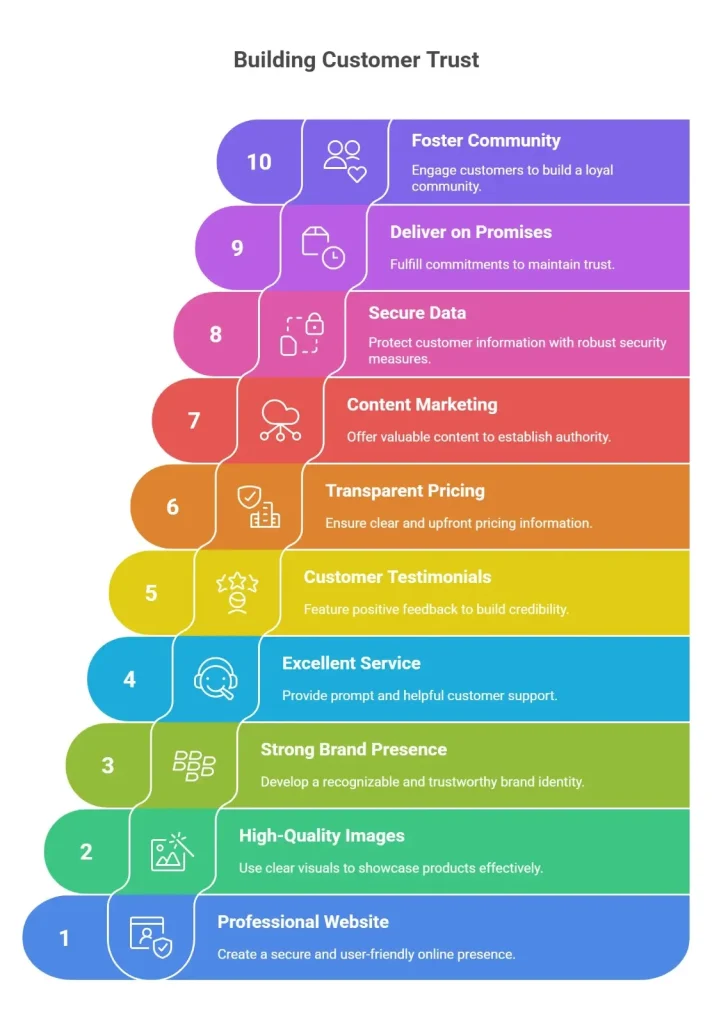In the fast-growing world of ecommerce, gaining customer trust is one of the most significant challenges for new businesses. Consumers today are more cautious than ever when shopping online, with concerns about fraud, product quality, and data security. Without user trust, even the best products and marketing strategies will fail to generate long-term success.
So, how can a new ecommerce business earn the confidence of its customers? In this blog, we’ll explore key strategies that can help establish user trust, boost credibility, and drive sales.

Why Customer Trust Matters in Ecommerce
User trust is the foundation of any successful ecommerce business. It influences purchasing decisions, customer loyalty, and brand reputation. Here’s why building trust is crucial:
- Increases Conversions: Customers are more likely to buy from a store they trust. A strong reputation can lead to higher conversion rates.
- Encourages Repeat Purchases: When customers trust a brand, they return for future purchases, leading to increased customer lifetime value.
- Generates Positive Word-of-Mouth: Satisfied customers share their experiences, helping to attract new buyers through recommendations.
- Reduces Cart Abandonment: Many customers abandon their carts due to security concerns or doubts about the product’s authenticity. Trust signals help minimize these fears.
Now, let’s explore the essential steps to establish customer trust for a new ecommerce business.
How to Build Trust With Customers

How to gain customer trust and confidence? Are you thinking about the same? Fret not. Here’s how to get started.
1. Create a Professional and Secure Website
The first impression matters. If your website looks outdated, unprofessional, or difficult to navigate, customers may hesitate to make a purchase. Here’s how to create a trustworthy website:
- Use a Clean and User-Friendly Design: Ensure your website is visually appealing, easy to navigate, and mobile-friendly.
- Display Trust Badges: Include SSL certificates, payment security logos (Visa, Mastercard, PayPal, etc.), and trust seals from organizations like Norton or McAfee.
- Optimize Website Speed: Slow-loading websites create frustration and reduce credibility. Use optimized images, caching, and a reliable hosting provider.
- Ensure a Secure Checkout Process: Implement encrypted payment gateways to protect customer data and transactions.
2. Offer High-Quality Product Images and Detailed Descriptions
Unclear or misleading product information is a major reason for distrust in ecommerce. Be transparent about your products by:
- Using High-Resolution Images: Provide multiple images from different angles to help customers see product details. Building trust with customers is a crucial hack to stay ahead.
- Including Videos and 360° Views: Videos demonstrating product use enhance credibility and engagement.
- Writing Accurate and Detailed Descriptions: Clearly mention product specifications, materials, dimensions, and usage instructions.
- Displaying Customer Reviews and Ratings: Reviews provide social proof and influence purchasing decisions.
3. Build a Strong Brand Presence
A well-established brand inspires confidence. Here’s how to strengthen your brand identity:
- Develop a Compelling Brand Story: Share your mission, values, and the inspiration behind your ecommerce business.
- Be Active on Social Media: Engage with customers on platforms like Instagram, Facebook, and LinkedIn to build relationships and credibility.
- Partner with Influencers: Collaborate with influencers in your niche to promote your products and gain customer trust.
- Create Consistent Branding: Use the same logo, color scheme, and messaging across all platforms to create a professional image.
4. Provide Excellent Customer Service
Outstanding customer service is one of the fastest ways to build customer trust. Here’s how you can achieve this:
- Offer Multiple Support Channels: Provide live chat, email, and phone support to address customer concerns quickly.
- Respond Promptly and Politely: Fast and friendly responses to inquiries and complaints show that you value customers.
- Implement a Clear Return and Refund Policy: Customers feel more confident buying from a store that offers hassle-free returns and refunds.
- Follow Up with Customers: Sending follow-up emails after purchases shows that you care about their experience.
5. Showcase Customer Testimonials and Reviews
Nothing builds customer trust like positive feedback from real buyers. Here’s how to leverage reviews:
- Encourage Verified Reviews: Ask customers to leave reviews after their purchase and verify them as real buyers.
- Feature User-Generated Content: Share customer photos and videos using your products to build authenticity.
- Display Testimonials on Key Pages: Highlight customer feedback on product pages, the homepage, and landing pages.
6. Be Transparent About Pricing and Policies
Hidden fees and unclear policies can lead to distrust and cart abandonment. Ensure transparency by:
- Displaying Full Pricing Upfront: Include taxes, shipping costs, and any additional charges in the checkout process.
- Clearly Stating Your Policies: Make return, refund, and shipping policies easy to find and understand.
- Providing Realistic Delivery Estimates: Set accurate expectations for shipping times to prevent disappointment.
7. Invest in Content Marketing
Educational content can establish your ecommerce business as an authority in your niche. Here’s how content marketing builds customer trust:
- Create Informative Blog Posts: Provide value through how-to guides, industry insights, and product comparisons.
- Use Video Marketing: Product demos, unboxings, and tutorials help customers feel more confident about their purchases.
- Offer Free Resources: Ebooks, downloadable guides, and FAQs position your brand as a helpful and reliable source.
8. Secure Customer Data and Privacy
Online shoppers are concerned about data privacy. Protecting their information is key to earning customer trust. Here’s how to do it:
- Implement Strong Security Measures: Use SSL encryption, two-factor authentication, and secure payment gateways.
- Comply with Data Protection Regulations: Follow GDPR, CCPA, or other relevant data privacy laws.
- Clearly Outline Your Privacy Policy: Inform customers how their data is collected, stored, and used.
9. Deliver on Promises
Nothing damages customer trust more than broken promises. Always:
- Deliver Products on Time: Stick to your shipping timelines to avoid disappointing customers.
- Maintain Product Quality: Ensure that your products match the descriptions and images provided.
- Honor Refund and Warranty Policies: If an issue arises, resolve it quickly and fairly.
10. Foster Community Engagement
A strong community helps reinforce customer trust. Encourage engagement by:
- Creating a Loyalty Program: Reward returning customers with discounts, exclusive offers, or points.
- Hosting Live Q&A Sessions: Answer customer questions in real time on social media.
- Encouraging Brand Advocacy: Invite satisfied customers to share their experiences and refer others.
Conclusion
Building customer trust for a new ecommerce business requires a combination of transparency, security, quality service, and strong branding. By creating a professional website, showcasing customer reviews, protecting data, and delivering on promises, you can earn the confidence of your audience and establish long-term success.
Trust takes time to build, but once earned, it becomes your most valuable asset in the competitive world of ecommerce. For more tips on supply chain management, contact Qodenext today.
FAQs – Customer Trust
1. Why is user trust important for a new ecommerce business?
Customer trust is crucial because it influences purchasing decisions, builds brand loyalty, and enhances the reputation of your ecommerce business.
2. How can I make my ecommerce website look more trustworthy?
You can improve user trust by using a clean design, displaying trust badges, offering secure payment options, and including detailed product descriptions and images.
3. What role do customer reviews play in building trust?
Customer reviews provide social proof, helping potential buyers feel confident about the quality and reliability of your products.
4. How to build trust with customers online?
Implement SSL encryption, use trusted payment gateways, comply with privacy laws, and clearly communicate your data protection policies.
5. What should I do if a customer has a bad experience?
Address the issue promptly, offer a fair resolution, and use the feedback to improve your products and services.
6. How do return and refund policies impact user trust?
A clear and fair return policy reassures customers that they can shop risk-free, making them more likely to complete a purchase.
7. Does social media help in building trust?
Yes, engaging with customers on social media helps humanize your brand, showcase customer feedback, and answer queries in real time.







